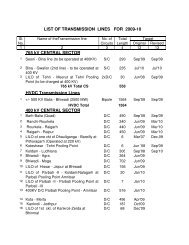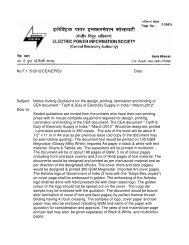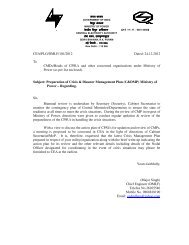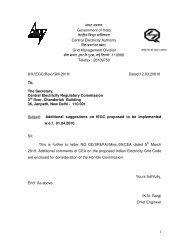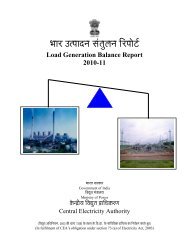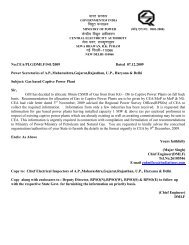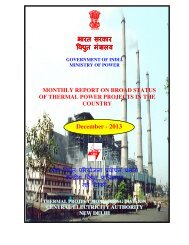Standard Technical Features of BTG System for Supercritical 660 ...
Standard Technical Features of BTG System for Supercritical 660 ...
Standard Technical Features of BTG System for Supercritical 660 ...
You also want an ePaper? Increase the reach of your titles
YUMPU automatically turns print PDFs into web optimized ePapers that Google loves.
<strong>Standard</strong> <strong>Technical</strong> <strong>Features</strong> <strong>of</strong> <strong>BTG</strong> <strong>System</strong> <strong>for</strong> <strong>Supercritical</strong> <strong>660</strong>/800 MW Thermal Unitsinventory management. For large size supercritical units also, the sameconfiguration i.e. 2x50 % TD-BFP and 1x50 % MD-BFP has been adopted.Alternate provision <strong>of</strong> 3x50% MDBFPs has also been suggested. However,this shall be resulting in increased auxiliary power consumption and reducednet unit output.1.2.6 Design pressure <strong>of</strong> HP heaters and feed water pipingIn case <strong>of</strong> sub-critical units, feed regulating station is generally located atdown stream <strong>of</strong> HP heaters, and HP heaters and feed water piping from BFPdischarge to boiler inlet are normally designed <strong>for</strong> the shut <strong>of</strong>f head condition<strong>of</strong> BFPs. However, in case <strong>of</strong> supercritical units, such a design criteria maylead to extremely high design pressure rating <strong>for</strong> HP heaters and lead toextremely high thicknesses <strong>for</strong> pipes and heater tube sheet etc. Thus, insupercritical units, feed regulating station is located at upstream <strong>of</strong> HP heatersand no isolation valve is provided at economiser inlet. The feed water pipingand HP heaters are designed as per design pressure <strong>of</strong> the boiler with provision<strong>of</strong> pressure relief valves across HP heaters or media operated three way valvesare provided at inlet/ outlet <strong>of</strong> HP heater(s) so as to prevent BFP shut <strong>of</strong>fpressure from being communicated to downstream piping system and HPheaters.1.2.7 Water chemistryUnlike the sub-critical units that <strong>of</strong>fer flexibility <strong>for</strong> water chemistrycorrection in the boiler (drum), the supercritical units require necessary qualitycorrection <strong>of</strong> condensate to ensure final steam quality. High chemicalconcentration in the boiler water and feed water cause furnace tube depositionand allow solids carryover into the superheater and turbine. Further, dissolvedoxygen attacks steel and rate <strong>of</strong> attack increases sharply with rise intemperature. Accordingly, water chemistry <strong>of</strong> boiler feed water is maintainedusing combined water treatment (oxygen dosing and ammonia dosing incondensate and feed water system). Oxygenated treatment (OT) using highpurity DM water minimizes corrosion and flow accelerated corrosion (FAC) inthe feed water train. Provision <strong>for</strong> dosing <strong>of</strong> ammonia and hydrazine (allvolatile treatment) is also made during start up and chemical excursions.Further, the units are also provided with 100 % condensate polishing units toachieve requisite condensate quality to the regenerative feed heating systems.1.2.8 ID fan selectionNormal practice in the country has been to provide radial type InducedDraught (ID) fans <strong>for</strong> upto 500 MW unit size as radial fans are consideredmore reliable specially under conditions <strong>of</strong> high dust loadings (and consequenthigh wear <strong>of</strong> fan). However, radial fans <strong>of</strong> high capacity (<strong>for</strong> <strong>660</strong>/800 MWunit size) may not be available and hence axial type variable pitch ID fanshave been adopted. These are more efficient and lead to considerable powersavings. Also with considerable improvements in ESP per<strong>for</strong>mance, problems<strong>of</strong> fan wear etc. are not expected to be significant.4





